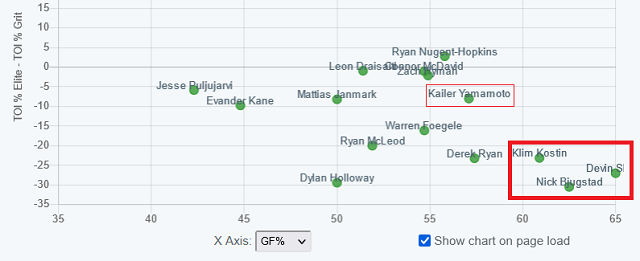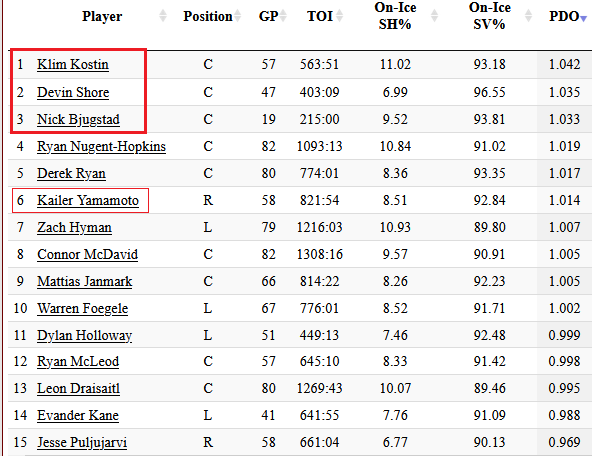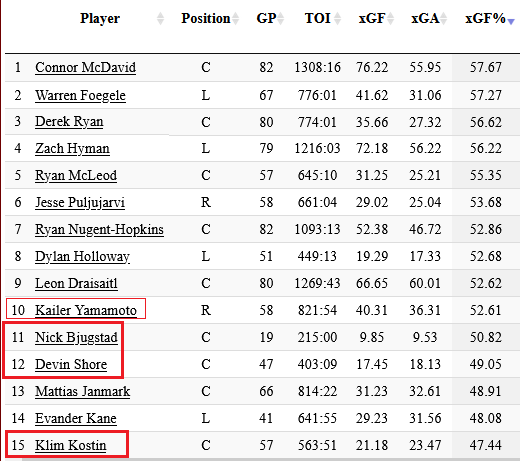It’s late July and all is quiet in the National Hockey League. So quiet in fact that those who continue to bring content often resort to rankings and predictions. Just in the last couple of weeks hardcore Cult of Hockey readers have learned that according to one expert the Edmonton Oilers’ prospect group is ranked 28th in the NHL (oh no!), that in the opinion of another wise man the Oilers have had the 5th best off-season of any NHL club so far (oh yeah!), and that a local iconoclast has seen the light and picked the Oil to win the Stanley Cup (let joy be unconfined!).
Of those proclamations, the middle one attracted my attention. The expert in question was Dom Luczczyszyn of The Athletic, who rated the early off-season of 2023 and was impressed with Ken Holland’s work. Sayeth Dom:
- The Oilers only made one addition this offseason and it’s a good one. Connor Brown comes in cheap and should fit perfectly anywhere in the team’s top nine. He’s a hardworking winger who can score and grind while being an asset at both ends of the ice. That’s a sizeable improvement from Kailer Yamamoto who just wasn’t working out in a top-six role anymore.
The rest of the team’s improvement here is from Nick Bjugstad and Klim Kostin no longer being on the roster. Both are viewed as below-average players though Edmonton’s actual improvement will depend on who the Oilers get to replace those players.
According to Dom, the Oilers shaved $4.8 million from the payroll, while improving their expected Goal Differential by fully 10 goals through that old sports equation, “addition by subtraction”.
Funny thing is, that very stat of Goal Differential or its ornery cousin 5v5 Goals For Percentage presented both Bjugstad and Kostin in a good light in 2022-23. Same goes for Yamamoto, and for yet a fourth departure not mentioned by Luczczyszyn, namely Devin Shore.
So here comes the funny part:
Hey lookit! The top four forwards on the Oilers in this important category are no longer with the team. The top four!
The above list includes all forwards to play at least 200 minutes at 5v5 for the Oilers last season, with the TOI bar set a little low in order to include deadline acquisition Bjugstad, who played 215 minutes at 5v5 in his 19 regular season games as an Oiler.
Of course there are minutes and then there are minutes. With the Oilers in recent years, the best production numbers traditionally occur during time spent with Connor McDavid, Leon Draisaitl, or best of all, both. And the best of those minutes come on the powerplay, as Ryan Nugent-Hopkins and Zach Hyman can gratefully attest.
But even at 5v5 the Oilers scored over 4 goals per 60 when both Connor and Leon roamed the sheet, and north of 3 GF/60 with either one without the other. With both on the bench, Edmonton scored a more modest 2.4 goals per 60, which nonetheless represents their best such rate in the entire McDavid-Draisaitl era and by some distance at that.
The Line Tool function at the superb resource Natural Stat Trick allows us to differentiate who played with whom, so I did a quick analysis of the departed quartet’s usage with the two superstars.
which quickly singles out Yamamoto as the lone top six forward in the group, having played nearly two-thirds of his ice time with one or both of the offensive drivers. Of the others, Kostin played about 1/7 of his 5v5 minutes with either star; Shore 1/15; Bjugstad 1 in 40.
I’d make the case that Yamamoto is the one departed Oiler who has definitively been replaced at this moment in time. His spot in or near the top six will be filled by Connor Brown, and at a quarter of the price tag in the season immediately to come. This miracle brought to you by Ken “Wimpy” Holland’s creative new “I’ll gladly pay you Tuesday for a hamburger today” approach to cap space. Dangerously assuming good health for the newcomer, that’s an instant upgrade on the ice; meanwhile the “found” cap space, however temporary, will go a long way towards resolving the Evan Bouchard and Ryan McLeod impasses.
Which leaves Kostin, Bjugstad and Shore as true departures from last season’s surprisingly successful bottom six. How successful? Here’s another look at their on-ice goal shares, this time factoring the impact of McDavid and Draisaitl. Which was pretty minimal on those three.
Each of the four now ex-Oilers had an on-ice goal share north of 60% when playing without 97 or 29. Yamamoto had a solid 56% goal share with one or both stars, but posted an even better 60% when without both. For the others “without both” was standard fare, yet all three crushed it in goal share as we first noticed up the page.
First reaction: did Oilers get rid of the wrong guys?
If goal share is our sole guide, then yes, yes they did. In truth that’s just one of many indicators. While very important in analyzing past results, goal share is an imperfect predictor of the future to say the least. It’s a nice arrow, but that’s all. So let’s dive a little deeper, though we’ll continue to stick entirely to regular season numbers.
Another splendid resource, PuckIQ, provides further nuance.
This chart features 5v5 goal share on the horizontal axis, where Kostin, Bjugstad and Shore are pleasingly far to the right, in the 60+% range. The vertical axis measures quality of competition, where that same trio is shown to face very weak opposition by and large. Which stands to reason when one considers how rarely they play with McDavid and Draisaitl, who are major priorities for every opponent the Oilers play. If the big guys see the toughs, those lower down the depth chart are unlikely to face a mismatch.
Which isn’t to say that over the years the Oil haven’t had far, far too many depth players wind up on the lower left of such a chart, a placement which roughly translates to “weak comp, still getting crushed”. This was not a problem in 2022-23, as we tracked here at the Cult of Hockey throughout the season. It was Edmonton’s bottom six doing the crushing for the most part.
Meanwhile the depth forwards the Oilers have retained were either well comfortably above that 50% rate (Warren Foegele, McLeod, Derek Ryan, Dylan Holloway) or faced significantly tougher competion (Mattias Janmark).
There’s only one way to get superior goal results from mediocre shot shares, and that’s to ride the percentages. I’m not going to call it “luck” like some do; that’s certainly part of it but it’s an oversimplification to handwave all variation away to Lady Luck’s devious charms. Occasionally the old trusim “you make your own luck” comes into play. Some players are superior shooters or playmakers. But you don’t generally find them clustered in the bottom six like these three worthies.
Like raw goal shares, Corsi is a so-so predictor of the future. In the case of goals, the sample size is small therefore volatile. With Corsi, the sample size is much larger, but with the huge caveat that not all shots are created equal. I for one would rather have a Draisaitl shot off a McDavid pass than, say, a Shore shot off a Kostin pass. Yet in 2022-23 the distribution of the percentages, and by extension the actual goals, at both ends of the sheet favoured the lesser lights.
A hot PDO is good in the here and now — the team with the higher PDO on the night wins a large majority of games — but is fraught with issues. It tends to raise not only expectations but actual salaries of players who had an extended run of it. Devin Shore may beg to differ, but both Kostin and Bjugstad have cashed in with significant raises with a bit of term.
Modern analysis has gone far beyond the early phases of isolating game states and then counting the quantity of goals and shots. In more recent times shot quality has entered the chat, and various statistical model have produced “magic bullet” style numbers that attempt to factor in details like shot location and type. One variation favoured by Natural Stat Trick among others is “eXpected Goals”, which is simply a projection of how many goals “should” be scored by and against a player’s team assuming a normal conversion rate of such shot opportunities.
Bjugstad and Shore fared slightly better here, the two of them straddling the 50% mark in xGF% though both among the bottom third of Oilers forwards. Kostin? Dead last.
Meanwhile, the depth forwards who hung around — Foegele, Ryan, McLeod, even Holloway — performed significantly better by this indicator than did those who moved on. Makes this observer wonder if the organization is finally making progress on the analytics front and not getting fooled by outsized, uhh, Percentage-Driven Outcomes.
A word about Kostin. I would suggest he’s a plus shooter, with a demonstrated capacity to jump on loose pucks in or near the slot and flat-out beat an NHL goalie from distance. That said, he managed just 56 shots in 57 games last season and buried 11 of them for a 19.6 Sh%. That was good enough to rank ninth among the 289 NHL forwards to score 10+ goals. Due respect to the Real Klim Shady, that’s unlikely to happen again.
My takeaway is that those gaudy goal shares played a major part in both Kostin’s and Bjugstad’s market value, with both guy’s cashing in for 2-year contracts at $2.0 and $2.1 per season respectively. The “good” news could very well be the fact they signed those contracts elsewhere.
Let’s give Dom L. the last word, by repeating part of what he said up top but changing the emphasis:
- The rest of the team’s improvement here is from Nick Bjugstad and Klim Kostin no longer being on the roster. Both are viewed as below-average players though Edmonton’s actual improvement will depend on who the Oilers get to replace those players.
Yep. Be that Dylan Holloway, Raphael Lavoie, Lane Pederson, Drake Caggiula or other depth forwards yet to be added, the opportunity is there but the bar is set high.







